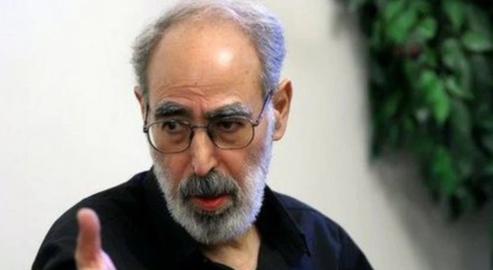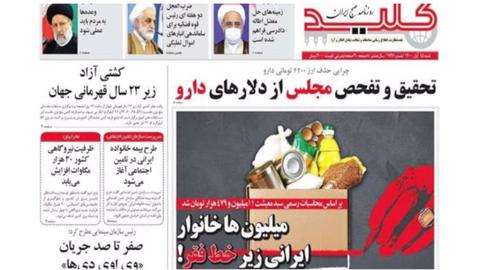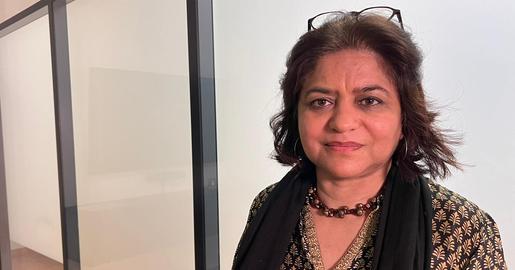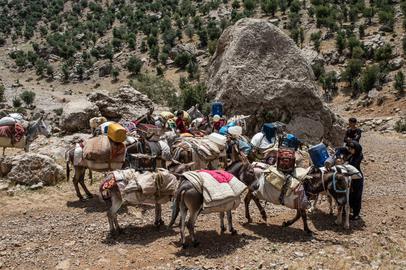On Saturday, November 6, 2021, on the eve of the second anniversary of the November 2019 protests, political activist Abolfazl Ghadyani, issued a statement calling Ali Khamenei the "mother of corruption" and the "main culprit" of the poverty and misery of the Iranian people.
On the same day, the newspaper Kelid republished a sketch published by Kayhan London newspaper, which is critical of the Islamic Republic, in which Ali Khamenei's hand drew the poverty line.Two days after the sketch was published, Kelid’s license was revoked.
According to official reports, in 2019 one third of Iranians were living below the poverty line. Also in 1976, three years before the 1979 Islamic Revolution, a third of Iranians lived below the poverty line.
Ali Khamenei, while he was a cleric and long before becoming Supreme Leader, said that those who protest bring their hardships on themselves. "People are the main victims of the [sanctions]. Officials [abroad] take their money and laugh at the revolutionaries.”
He also repeatedly spoke of the importance of supporting the oppressed. In the winter of 1980, with Mohammad Ali Rajaei, then the prime minister and the second president of Iran, Khamenei said: "Those who protect this Revolution are the oppressed. [...] It is the weak and barefoot strata of this society that bear high prices and tolerate shortages."
As president a year and a half after the 1980-88 Iran-Iraq war, Khamenei then {{ __192230_videocomponent__video component__ }}" style="">spoke at the tomb of the eighth Shiite Imam. Hundreds of thousands of young people had been killed in the war, infrastructure was destroyed, and poverty was on the rise. In his speech, referring to poverty and famine in the time of Imam Ali in the seventh century, seen as the “most just” of the Shia Imams, Khamenei said: "If Imam Ali had ruled for another 10 or 20 years, there is no doubt that poverty would have been eradicated in society. If the Islamic Republic is very ambitious, it can become the Shia government of Imam Ali."
Decades have passed since this address. Poverty has not been eradicated and, according to the latest official statistics, a third of Iranian society has fallen below the poverty line, a trend which most observers believe will continue. In August this year, the Ministry of Labor, Cooperatives and Social Welfare for the first time published an official report on the poverty line in Iran, according to which, in 2020, the per capita poverty was equal to 1.252 million tomans ($46) while the 2019 poverty rate had also increased by about 32 percent on the previous year. The poverty rate in 2020 was not mentioned, ostensibly due to the unavailability of expenditure and income data.
A different report by Tejarat News states that in 2019, of Iran’s population of 84 million, more than 26 million lived below the poverty line. Given the loss of about 1.5 million jobs in the spring of 2020, the majority of which were informal occupations of the lower deciles of society, and 67 percent inflation in 2020 and the current year, it is safe to assume the situation will now be worse.
Khamenei went to Mashhad again in April 2018. In his new year speech he compared the poverty rate with that of the period before the 1979 Revolution, based on World Bank statistics: "Before the Revolution, 46 percent of the people in Iran were poor, but by 2014 this figure had reached 9.5 percent." In February 2019, Mohammad Ali Jafari, commander of the Islamic Revolutionary Guard Corps, called the 36 percent reduction in official poverty "a great honor for the Islamic system."
This claim was checked by the Fact-Nameh fact-checking service and was shown to be false. According to Fact-Nameh’s researchers, neither in the World Bank Open Data nor in the latest World Bank Poverty and Equity Brief is there any trace of the figures mentioned. There are no specific statistics covering the period before the Islamic Revolution. The only available source is an article entitled Revolution and the Distribution of Wealth in Iran written in the spring of 2006 by Javad Salehi Esfahani, an economist at Virginia Tech University. According to this article, which draws on Iran’s 1976 census, one third of the Iranian people at that time were living below the poverty line.
"At that time, the urban population of Iran was about 15.8 million and the rural population was about 17.9 million,” Salehi Esfahani wrote. "On this basis, the poor population at that time must have been something like 6.7 million of the rural poor and about 4 million of the urban poor. That is, about a third of Iran's population of 33.7 million at that time (about 11.6 million people, or 4.34 percent of the total population) lived below the poverty line."
In 2013, five years before Khamenei made this false claim, Reuters estimated that the Supreme Leader controls wealth of up to $US95 billion through Executive Headquarters of the Imam’s Directive. This is about 40 percent more than Iran's oil exports in 2012 and even more than the wealth of Iran’s former Shah. It makes Khamenei one of the 20 richest people in the world.
In March 2000, Khamenei had said at a meeting with students of Amirkabir University: "If freedom is lost, that will be a tragedy. Any kind of tyranny and dictatorship, and the fact that a person wants to take the fate of the people into its own hands, based on the vote and his own selfishness, is rejected, and if it happens somewhere, it will be a catastrophe."
But during Khamenei’s rule poverty and unemployment have only increased. In November 2019, when, according to the official report of the Islamic Republic, one third of the Iranian people were below the poverty line, protesters took to the streets over fuel price increases. The Aban Tribunal taking place this week in London, UK is hearing testimonies of protesters killed by security forces in these demonstrations. Now, two years after those protests, a newspaper that drew attention to poverty has been summarily shut down.
Abolfazl Ghadyani, like many others, blamed Khamenei for the killings during the protests, saying the Supreme Leader had "systematically" imposed poverty on them. He warned Khamenei to either give up his "evil power" or that the people would overthrow him.
Related coverage:
Jailed Critic to Khamenei: Your Time's Running Out
Poverty Rate in Iran 'Doubled' in Three Years
Record-Breaking Inflation Confronts Raisi's New Presidency
Worsening Inflation Casts a Shadow Over Iranian New Year
Iranians Enter a New Century Poorer and Less Hopeful for the Future
Why Inflation is Hitting the Poor in Iran Hardest
Poverty in Iran: An Introduction
Revealed: Absolute Poverty in Iran
Decoding Iran’s Politics: All the Supreme Leader’s Institutions


























comments